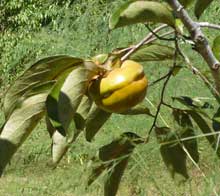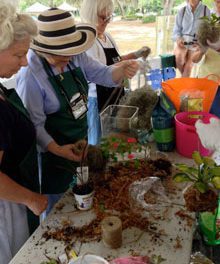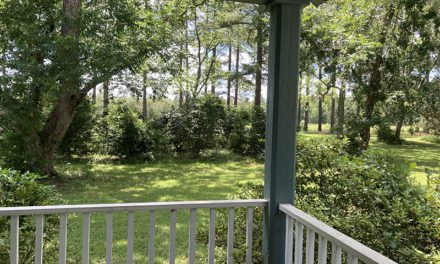 American Persimmon, Diospyros virginiana, is a native tree that has small orange fruit and roundish to elliptical dark green leaves.
American Persimmon, Diospyros virginiana, is a native tree that has small orange fruit and roundish to elliptical dark green leaves.
Many fruit lovers also grow or buy Asian Persimmon, Diospyros kaki, which has a large fruit and also has attractive large dark glossy green leaves. The native persimmon, D. virginiana, is one of the deciduous hardwoods of the Southeastern forest and can range in a variety of soils and elevations from Connecticut to Texas. There grows a Texas, Mexican, or black persimmon (D.texana) whose habitat is limited to the bottom of Texas and Northeastern Mexico and will grow at elevations up to 4000′ in mostly dry, rocky and open woodlands. The fruit of this tree is black and, while edible, may also be used as a dye, staining hands, teeth and tongue. They are all members of the ebony (Ebenaceae) family. The wood of D. virginiana is very hard and straight and was harvested, historically, for the heads of golf clubs and furniture veneer. The bark is patterned with attractive small squares.
Our common persimmon is an uncommonly handsome tree with white bell shaped flowers, glossy dark green leaves which turn yellow in the fall, and brownish-charcoal grey bark on a 30′-60′ straight trunk. The white fragrant flowers which are found at the leaf base will be male or female on separate trees. Two or more male flowers are usually grouped on current years’ growth; female flowers are larger, single, and attached closely to the leaf axil. The female flowers will become the ovary-fruit (or berry) if it is pollinated which usually happens because they bloom well after frost. Native Persimmon fruit is small and about an inch or two in diameter containing 4-8 large flat seeds. Fruit cannot be eaten before ripening, because they contain tannins and are very astringent. When they are ripe they turn orange to purplish brown. The ripe orange pulp from both Asian and native persimmons are used in pies, puddings, cookies and bread recipes. There are named cultivars of native and Asian persimmons. The Asian are usually self-pollinating and may not be astringent. When purchasing any fruit tree it is important to know if it needs a pollinator.
Persimmons are just as important as food for wildlife. Raccoons, deer, birds and opossums also enjoy the ripe fruit and will often be feeding up in, or just under, the tree. The American Heritage Dictionary says that the word persimmon is “of Algonquin origin; akin to Cree, pasiminan, dried fruit.” While the fruits were definitely used by American Indians in breads and eaten raw, they were also dried like prunes. The genus for Diospyros from the Greek translates, “fruit of the god Zeus.”
http://www.clemson.edu/extension/hgic/plants/vegetables/tree_fruits_nuts/hgic1357.html







